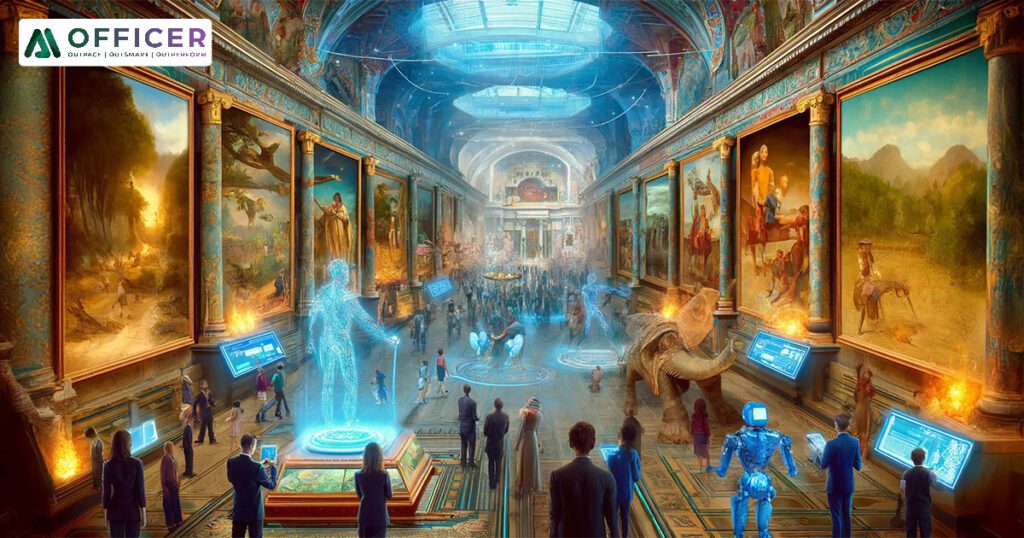
The hushed halls of museums, once filled with the echoes of footsteps and the rustling of dusty labels are undergoing a transformation.
Artificial intelligence (AI) is revolutionizing the museum experience, breathing new life into static displays and igniting a passion for discovery in visitors of all ages.
Imagine a museum where exhibits come alive, tailored to your interests and ready to answer your questions.
AI-powered tools are making this vision a reality, fostering deeper engagement and transforming museums from passive repositories of the past into dynamic hubs of interactive learning.
This exciting evolution is not just a glimpse into the future; it’s happening right now, and it’s poised to redefine how we experience art, history and culture. Dive into this blog to explore how AI is revolutionizing museums and creating unforgettable journeys for every visitor.
Stepping into the Future – AI is Reshaping Museums
AI’s impact on museums is multifaceted. Here are some exciting ways it’s changing the game :
- Personalized Tours
No more one-size-fits-all experiences! AI algorithms can analyze visitor data (anonymously, of course) to create personalized tours. Love Egyptian mummies? Your AI companion will whisk you through the mummy exhibit, highlighting fascinating details and historical context. The National Gallery of Singapore is already piloting this technology, ensuring every visitor has a unique learning journey.
- Interactive Storytelling
Gone are the days of static displays with wall text that puts you to sleep faster than a lullaby. Interactive AI chatbots and robots are stepping in as virtual storytellers. These engaging characters can answer your questions in real-time, share historical anecdotes, and even bring historical figures to “life” through dialogue. The Smithsonian Institution’s “Remembering Slavery” project explores this concept, allowing visitors to interact with a virtual enslaved person, fostering a deeper understanding of this dark chapter in history.
- Augmented Reality (AR) Overlays : Ever wanted to see a T-Rex roam the museum halls? AR can make it happen! By using smartphones or tablets, visitors can view digital overlays that bring exhibits to life in stunning detail. The Metropolitan Museum of Art’s “Met Cloisters AR App” allows visitors to virtually explore the medieval gardens, adding a whole new dimension to the experience.
These are just a few examples and the possibilities are constantly expanding as AI technology evolves. But with any innovation, challenges need to be addressed.
Challenges and Considerations
While AI offers a treasure trove of possibilities, some challenges need to be addressed :
- Accessibility : Not everyone has access to smartphones or tablets needed for AR experiences. Museums need to ensure inclusivity by providing alternative options like physical replicas or interactive touchscreens.
- Accuracy and Bias : AI systems rely on data. Biased data can lead to biased information being presented. Museums need to ensure their AI tools are trained on accurate and diverse datasets to avoid perpetuating historical inaccuracies or stereotypes.
- The Human Touch : While AI offers a wealth of information, it can’t replace the human element of museum visits. Skilled docents and curators will always be essential for fostering deeper connections with exhibits, providing personalized insights, and sparking meaningful conversations with visitors.
These challenges can be addressed through careful planning and collaboration. The key is to leverage AI’s strengths while ensuring a well-rounded and inclusive museum experience for all.
Museums around the world are already embracing AI.
The Anglo Sikh Museum uses digital twins and photogrammetry to create interactive 3D models of their collections, allowing visitors to explore artifacts in ways that were previously impossible (Hidonix).
The Manchester Museum employs haptic technology to let visitors virtually “touch” exhibits, creating a tactile and immersive experience (Draw & Code).
The National Gallery of Singapore utilizes AI-powered guides that tailor tours to visitor interests, personalizing the learning journey.
The Smithsonian Institution is exploring AI chatbots that act as virtual storytellers, bringing historical figures to “life” through dialogue.
The Metropolitan Museum of Art offers an AR app that allows visitors to virtually explore the medieval gardens, adding a whole new dimension to the experience.
We believe in the power of AI to make museums more engaging and accessible for everyone. Ready to explore the possibilities?
Contact our AI Officers today for a free consultation and discuss how AI can transform your museum!
Stay tuned to our blog for more insightful articles on how AI is shaping our world.




